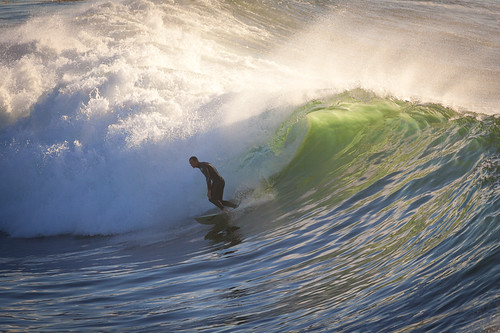
Another year, another trip, another bag shot (last year, +JCH). This time, the destination was the Bay Area of northern California. The bag is the same, but the contents are almost completely different.
Fujifilm X100S, from LensRentals and the main camera of the trip. I'd been drooling over the Fuji cameras for a while, but I'd never actually used one. This trip seemed like the perfect opportunity. I plan to put my impressions of the X100S in another post.
Hasselblad Xpan, because I can't seem to leave it behind on big trips, and I had an unfinished roll of Velvia inside.
Canon 1D Mark II, the old sports workhorse. Surfing is one of my favorite sports to shoot, and northern California is a bit of a mecca for surfers, so this was a no-brainer in spite of the size of the kit. I'm pretty sure the 1D charger alone is larger than the whole Fuji kit.
Canon 400/5.6 L USM, my current go-to, long-reach sports lens. It's about as good as a lightweight 400mm lens can be. I used to have the Canon 400/2.8 L USM, which was a stunning lens, but it was a beast to travel with, and was hard to justify owning once I stopped shooting sports regularly.
Manhattan Portage Europa Medium Messenger Bag, because it's light weight, well made, looks sharp, and can swallow a ton of stuff when expanded. Even I was amazed when I got the 400 in there with the 1D, 1D charger, and Xpan.
Sea to Summit Soft Cell, otherwise known as the Xpan Go Bag. These days it's more organized thanks to the Tiffen filter case to the bottom.
Canon 400/5.6 lens case, because the Manhattan Portage bag doesn't have any padding. I hate overly-padded bags that add bulk and weight.
Two rolls of Kodak Portra 400, a nice, general purpose film for traveling, with good color rendition.
One roll of Kodak Tri-X 400, which needs no explanation.
One roll of Ilford FP4 Plus 125, which I've been meaning to try for a while now.
Think Tank Pee Wee Pixel Pocket Rocket (red), for the the X100S SD cards. I had to scrounge for enough SD cards for the trip since most of my storage is compact flash for the ol' 5D and 1D.
Think Tank Pixel Pocket Rocket (gray), for the 1D CF cards. I brought way more than I needed, but this was one of the few opportunities I would get to shoot surfing (we don't get much surfing here in Denver), so I certainly didn't want to run out. I also brought some smaller, obsolete CF cards that I could just give to people if they needed a photographer in a pinch.
Kalt Blower Brush, for the battle against dust.
Garmin eTrex Venture HC, so I'd know where I'd been. It's also fun to add new trails and locations to OpenStreetMap whenever possible.
Extra pair of glasses (in the white case), so I'm not completely helpless if something happens to my main glasses. Really they're just the glasses from my previous prescription; better than nothing.
National Park Passport, because it's fun to get stamps for the parks my wife and I have visited.
Moleskine notepads, for writing stuff down, though I find myself using my iPhone for notes more and more.
Peter Turnley card, from the San Francisco Leica Store, which had his French Kiss series on display. If you ever get a chance to see his work in person, I highly recommend it. The SF Leica Store itself is a very nice space with plenty of new and old gear to drool over. The staff were very friendly and didn't bat an eye when I took out the Fuji for a couple shots. It definitely made me wish I had my M6 or CL with me though.
I didn't carry all this gear around all the time. The San Francisco Bay Area is hilly (understatement) and I certainly didn't want to bring the 1D and 400. There were times when I wanted the Xpan, but even that was too heavy for a full day on foot. Most of the time I just had the X100S, a bottle of water, and a pull-over fleece in the bag. In the end, one decent camera is all you really need.











